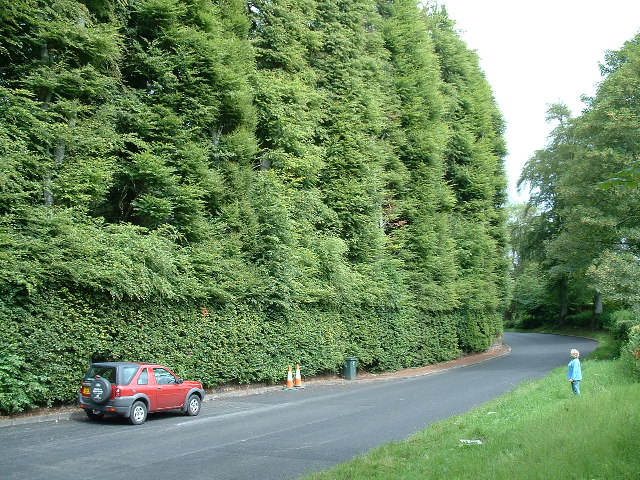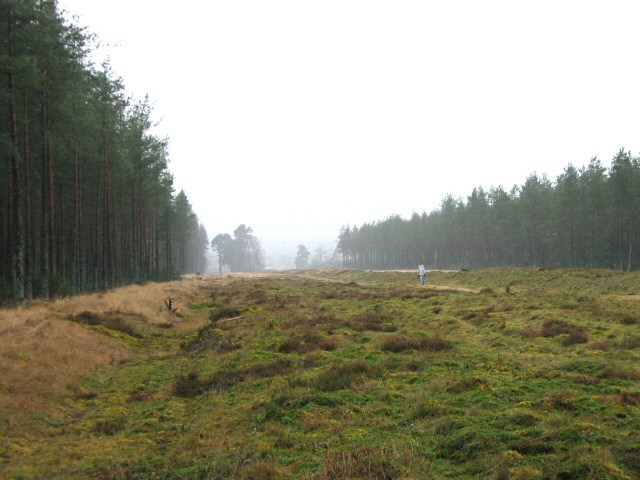|
Meikleour Beech Hedges
The Meikleour Beech Hedge(s) (European Beech = ''Fagus sylvatica''), located near Meikleour, Perth and Kinross, Scotland, was planted in the autumn of 1745 by Jean Mercer and her husband Robert Murray Nairne on the Marquess of Lansdowne's Meikleour estate. It is said the hedge grows towards the heavens because the men who planted it were killed at the Battle of Culloden. The hedge lies alongside the A93 Perth- Blairgowrie Road, and can be viewed by visitors all year round. In 1906 Henry John Elwes and Augustine Henry, in the first volume of their ''Trees of Great Britain and Ireland'', mention the "celebrated beech hedge of Meikleour" as one of the most striking effects produced by the beech in Scotland. "This hedge forms the boundary between the grounds and the highway, and has to be cut in periodically, which is done by men working on a long ladder, from which they are able to reach with shears to about 60 feet. Local history says that this hedge was planted in 1745, and ... [...More Info...] [...Related Items...] OR: [Wikipedia] [Google] [Baidu] |
Meikleour
Meikleour ( ) is a village in Perth and Kinross, Scotland. It lies near the confluence of the River Tay, Tay and the River Isla, Perthshire, Isla in the valley of Strathmore, Angus, Strathmore, north of Perth, Scotland, Perth and south of Blairgowrie and Rattray, Blairgowrie. It is in the parish of Caputh, Perth and Kinross, Caputh. Meikleour is home to the Meikleour Beech Hedges, Meikleour Beech Hedge, which was planted in 1746. The hedge is said to be the longest and tallest in the world and runs alongside the A93 road from Perth to Blairgowrie. The hedge is on the edge of the estate of Meikleour House, which itself is designated as an outstanding level of interest environment by Historic Environment Scotland. A substantial Neolithic cursus called Cleaven Dyke is nearby. The Meikleour Arms, on an Old Military Road, is a Category B listed building dating to 1820. Other features of the village include a 17th century mercat cross and a tron (Scotland), tron, complete with jou ... [...More Info...] [...Related Items...] OR: [Wikipedia] [Google] [Baidu] |
Henry John Elwes
Henry John Elwes, Royal Society, FRS (16 May 1846 – 26 November 1922) was a British botanist, entomologist, author, Lepidoptera, lepidopterist, Collecting, collector and traveller who became renowned for collecting specimens of lilies during trips to the Himalaya and Korea. He was one of the first group of 60 people to receive the Victoria Medal (horticulture), Victoria Medal of the Royal Horticultural Society in 1897. Author of ''Monograph of the Genus Lilium'' (1880), and ''The Trees of Great Britain & Ireland'' (1906–1913) with Augustine Henry, as well as numerous articles, he left a collection of 30,000 butterfly specimens to the Natural History Museum, London, Natural History Museum, including 11,370 specimens of Palearctic realm, Palaearctic butterflies.Salmon, M. A. (2000). ''The Aurelian Legacy: British Butterflies and Their Collectors''. Harley Books, Colchester. Biography Henry John Elwes was the eldest son of John Henry Elwes of Colesbourne Park near Cheltenh ... [...More Info...] [...Related Items...] OR: [Wikipedia] [Google] [Baidu] |
Tourist Attractions In Perth And Kinross
Tourism is travel for pleasure, and the commercial activity of providing and supporting such travel. UN Tourism defines tourism more generally, in terms which go "beyond the common perception of tourism as being limited to holiday activity only", as people "travelling to and staying in places outside their usual environment for not more than one consecutive year for leisure and not less than 24 hours, business and other purposes". Tourism can be domestic (within the traveller's own country) or international. International tourism has both incoming and outgoing implications on a country's balance of payments. Between the second half of 2008 and the end of 2009, tourism numbers declined due to a severe economic slowdown (see Great Recession) and the outbreak of the 2009 H1N1 influenza virus. These numbers, however, recovered until the COVID-19 pandemic put an abrupt end to the growth. The United Nations World Tourism Organization has estimated that global international tourist a ... [...More Info...] [...Related Items...] OR: [Wikipedia] [Google] [Baidu] |
Topiary
Topiary is the horticultural practice of training perennial plants by clipping the foliage and twigs of trees, shrubs and subshrubs to develop and maintain clearly defined shapes, whether geometric or fanciful. The term also refers to plants which have been shaped in this way. As an art form it is a type of living sculpture. The word derives from the Latin word for an ornamental landscape gardener, ''topiarius'', a creator of ''topia'' or "places", a Greek word that Romans also applied to fictive indoor landscapes executed in fresco. The plants used in topiary are evergreen, mostly woody, have small leaves or needles, produce dense foliage, and have compact or columnar (e.g., fastigiate) growth habits. Common species chosen for topiary include cultivars of European box (''Buxus sempervirens''), arborvitae (''Thuja'' species), bay laurel (''Laurus nobilis''), holly (''Ilex'' species), myrtle ('' Eugenia'' or ''Myrtus'' species), yew (''Taxus'' species), and privet ('' Ligust ... [...More Info...] [...Related Items...] OR: [Wikipedia] [Google] [Baidu] |
Guinness World Records
''Guinness World Records'', known from its inception in 1955 until 1999 as ''The Guinness Book of Records'' and in previous United States editions as ''The Guinness Book of World Records'', is a British reference book published annually, listing world records both of human achievements and the extremes of the natural world. Sir Hugh Beaver created the concept, and twin brothers Norris and Ross McWhirter co-founded the book in London in August 1955. The first edition topped the bestseller list in the United Kingdom by Christmas 1955. The following year the book was launched internationally, and as of the 2025 edition, it is now in its 70th year of publication, published in 100 countries and 40 languages, and maintains over 53,000 records in its database. The international franchise has extended beyond print to include television series and museums. The popularity of the franchise has resulted in ''Guinness World Records'' becoming the primary international source for cata ... [...More Info...] [...Related Items...] OR: [Wikipedia] [Google] [Baidu] |
Hedge
A hedge or hedgerow is a line of closely spaced (3 feet or closer) shrubs and sometimes trees, planted and trained to form a barrier or to mark the boundary of an area, such as between neighbouring properties. Hedges that are used to separate a road from adjoining fields or one field from another, and are of sufficient age to incorporate larger trees, are known as hedgerows. Often they serve as windbreaks to improve conditions for the adjacent crops, as in bocage country. When clipped and maintained, hedges are also a simple form of topiary. A hedge often operates as, and sometimes is called, a "live fence". This may either consist of individual fence posts connected with wire or other fencing material, or it may be in the form of densely planted hedges without interconnecting wire. This is common in tropical areas where low-income farmers can demarcate properties and reduce maintenance of fence posts that otherwise deteriorate rapidly. Many other benefits can be obtained d ... [...More Info...] [...Related Items...] OR: [Wikipedia] [Google] [Baidu] |
Augustine Henry
Augustine Henry (2 July 1857 – 23 March 1930) was a British-born Irish plantsman and sinologist. He is best known for sending over 15,000 dry specimens and seeds and 500 plant samples to Kew Gardens in the United Kingdom. By 1930, he was a recognised authority and was honoured with society membership in Belgium, Czechoslovakia, Finland, France, and Poland. In 1929 the Botanical Institute of Peking dedicated to him the second volume of ''Icones plantarum Sinicarum'', a collection of plant drawings. In 1935, ''John William Besant'' was to write: 'The wealth of beautiful trees and flowering shrubs which adorn gardens in all temperate parts of the world today is due in a great measure to the pioneer work of the late Professor Henry'.Besant, J. W. (1935) 'Plantae Henryanae', ''Gard. Chron.'' 98 (9 November 1935): 334–335. Early life and education Henry was born on 2 July 1857 in Dundee, Scotland to Bernard (a flax merchant) and Mary (née McNamee) Henry; the family returned to C ... [...More Info...] [...Related Items...] OR: [Wikipedia] [Google] [Baidu] |
Blairgowrie And Rattray
Blairgowrie and Rattray () is a Twin cities (geographical proximity), twin burgh in Perth and Kinross, Scotland. Locals refer to the town as "Blair". Blairgowrie is the larger of the two former burghs which were united by an Act of Parliament in 1928 and lies on the southwest side of the River Ericht while Rattray is on the northeast side. Rattray claims to be the older and certainly Old Rattray, the area round Rattray Kirk, dates back to the 12th century. New Rattray, the area along the Boat Brae and Balmoral Road dates from 1777 when the River was spanned by the Brig o' Blair. The town lies on the north side of Strathmore, Angus, Strathmore at the foot of the Grampian Mountains. The west boundary is formed by the Knockie, a round grassy hill, and Craighall Gorge on the Ericht. Blairgowrie and Rattray developed over the centuries at the crossroads of several historic routes with links from the town to Perth, Scotland, Perth, Coupar Angus, Alyth and Braemar. The roads to Coup ... [...More Info...] [...Related Items...] OR: [Wikipedia] [Google] [Baidu] |
620-250 Year Old Beech Hedg
6 (six) is the natural number following 5 and preceding 7. It is a composite number and the smallest perfect number. In mathematics A six-sided polygon is a hexagon, one of the three regular polygons capable of tiling the plane. A hexagon also has 6 edges as well as 6 internal and external angles. 6 is the second smallest composite number. It is also the first number that is the sum of its proper divisors, making it the smallest perfect number. It is also the only perfect number that doesn't have a digital root of 1. 6 is the first unitary perfect number, since it is the sum of its positive proper unitary divisors, without including itself. Only five such numbers are known to exist. 6 is the largest of the four all-Harshad numbers. 6 is the 2nd superior highly composite number, the 2nd colossally abundant number, the 3rd triangular number, the 4th highly composite number, a pronic number, a congruent number, a harmonic divisor number, and a semiprime. 6 is also the first ... [...More Info...] [...Related Items...] OR: [Wikipedia] [Google] [Baidu] |
Perth, Scotland
Perth (; ) is a centrally located Cities of Scotland, Scottish city, on the banks of the River Tay. It is the administrative centre of Perth and Kinross council area and is the historic county town of Perthshire. It had a population of about in . There has been a settlement at Perth since prehistory, prehistoric times. It is a natural mound raised slightly above the flood plain of the Tay. The area surrounding the modern city is known to have been occupied ever since the arrival of Mesolithic hunter-gatherers. Nearby Neolithic standing stones and circles date from about 4,000 Anno Domini, BC, a period that followed the introduction of farming into the area. Close to Perth is Scone Abbey, which formerly housed the Stone of Scone (also known as the Stone of Destiny), on which the King of Scots were traditionally crowned. This enhanced the early importance of the city, and Perth became known as a "capital" of Scotland due to the frequent residence there of the royal court. Royal ... [...More Info...] [...Related Items...] OR: [Wikipedia] [Google] [Baidu] |







